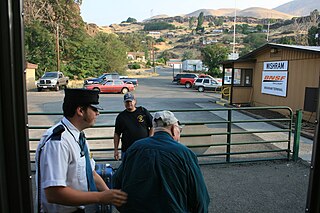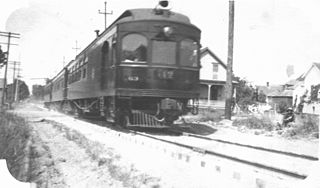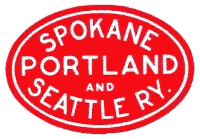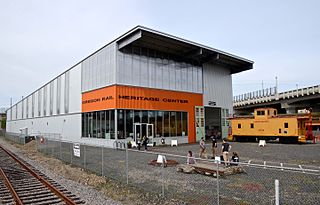
Wishram is an unincorporated community and census-designated place (CDP) in Klickitat County, Washington, United States. The population was 366 at the 2020 census. The site of the historic Celilo Falls is nearby.

The Great Northern Railway was an American Class I railroad. Running from Saint Paul, Minnesota, to Seattle, Washington, it was the creation of 19th-century railroad entrepreneur James J. Hill and was developed from the Saint Paul & Pacific Railroad. The Great Northern's route was the northernmost transcontinental railroad route in the U.S.

The Oregon Electric Railway (OE) was an interurban railroad line in the U.S. state of Oregon that linked Portland to Eugene.

The Empire Builder is a daily long-distance passenger train operated by Amtrak between Chicago and either Seattle or Portland via two sections west of Spokane. Introduced in 1929, it was the flagship passenger train of the Great Northern Railway and was retained by Amtrak when it took over intercity rail service in 1971.

The BNSF Railway Bridge 5.1, also known as the St. Johns Railroad Bridge or the Willamette River Railroad Bridge, is a through truss railway bridge with a vertical lift that spans the Willamette River in Portland, Oregon, United States. Built by the Spokane, Portland and Seattle Railway (SP&S) and completed in 1908, it was originally a swing-span bridge, and its swing-span section was the longest in the world at the time. However, 81 years later the main span was converted from a swing-type to a vertical-lift type, in order to widen the navigation channel. The lift span is one of the highest and longest in the world. The bridge consists of five sections, with the two sections closest to the bank on each side fixed.

Portland Union Station is a train station in Portland, Oregon, United States, situated near the western shore of the Willamette River in Old Town Chinatown. It serves as an intermediate stop for Amtrak's Cascades and Coast Starlight routes and, along with King Street Station in Seattle, is one of two western termini of the Empire Builder. The station is a major transport hub for the Portland metropolitan area with connections to MAX Light Rail, the Portland Streetcar, and local and intercity bus services. The station building contains Wilf's Restaurant & Bar on the ground level and offices on the upper floors. It also has Amtrak's first Metropolitan Lounge on the West Coast, which is reserved for first-class sleeping car and business-class passengers.

The Spokane, Portland & Seattle Railway was a railroad in the northwest United States. Incorporated in 1905, it was a joint venture by the Great Northern Railway and the Northern Pacific Railway to build a railroad along the north bank of the Columbia River. The railroad later built or acquired other routes in Oregon. The SP&S was merged into the Burlington Northern in March, 1970. Remnants of the line are currently operated by BNSF Railway and the Portland and Western Railroad.

The North Coast Limited was a named passenger train operated by the Northern Pacific Railway between Chicago and Seattle via Bismarck, North Dakota. It started on April 29, 1900, and continued as a Burlington Northern Railroad train after the merger on March 2, 1970 with Great Northern Railway and the Chicago, Burlington and Quincy Railroad. The next year, it ceased operations after the trains which left their originating stations on April 30, 1971, the day before Amtrak began service, arrived at their destinations.

Southern Pacific 4449, also known as the Daylight, is the only surviving example of Southern Pacific Railroad's GS-4 class of 4-8-4 Northern type steam locomotives and one of only two streamlined GS class locomotives preserved, the other being GS-6 No. 4460 at the National Museum of Transportation in St. Louis, Missouri. GS is an abbreviation of General Service or Golden State, the latter of which was a nickname for California, where the locomotive was used to operate in revenue service.

Spokane, Portland & Seattle 700 is the oldest and only surviving example of the class "E-1" 4-8-4 "Northern" type steam locomotive and the only surviving "original" Spokane, Portland and Seattle Railway steam locomotive. It was built by the Baldwin Locomotive Works in May 1938. Nearly identical to the class "A-3" Northerns built for Northern Pacific Railway, it burns oil instead of coal.
The Ilwaco Railway and Navigation Company operated a 3 ft narrow gauge railroad that ran for over forty years from the bar of the Columbia River up the Long Beach Peninsula to Nahcotta, Washington, on Willapa Bay. The line ran entirely in Pacific County, Washington, and had no connection to any outside rail line. The railroad had a number of nicknames, including the "Clamshell Railroad" and the "Irregular, Rambling and Never-Get-There Railroad."

Fargo Station is a train station in Fargo, North Dakota, United States. It is served by Amtrak's Empire Builder. It is the only railway station in use in the Fargo-Moorhead area and is the third-busiest in North Dakota. The platform, tracks, and station are currently all owned by BNSF Railway. The station is currently located in the former BNSF freight house. The former main station building is now home to Great Northern Bicycle Co.

Samtrak was a heritage railroad that operated in Oregon from 1993 to 2001.

Burlington Northern Railroad Bridge 9.6 or BNSF Railway Bridge 9.6, also known as the Columbia River Railroad Bridge, is through truss railway bridge across the Columbia River, between Portland, Oregon, and Vancouver, Washington, owned and operated by BNSF Railway. Built by the Spokane, Portland and Seattle Railway (SP&S) and completed in 1908, it was the first bridge of any kind to be built across the lower Columbia River, preceding the first road bridge, the nearby Interstate Bridge, by a little more than eight years.
Rail transportation is an important element of the transportation network in the U.S. state of Oregon. Rail transportation has existed in Oregon in some form since 1855, and the state was a pioneer in development of electric railway systems. While the automobile has displaced many uses of rail in the state, rail remains a key means of moving passengers and freight, both within the state and to points beyond its borders.
The SP&S Class A-1 steam locomotives were a group of 5 identical locomotives. They were used in the rail yards at Portland, Oregon, and Vancouver, Washington, from 1907 to 1952. They were replaced with diesel-electric switch locomotives.

The Oregon Slough Railroad Bridge, also known as the BNSF Railway Bridge 8.8, is a swing-span, through truss bridge in Portland, Oregon, United States. Currently owned and operated by BNSF Railway, it crosses an anabranch of the Columbia River known as North Portland Harbor and historically as the Oregon Slough. The bridge's northern end is on Hayden Island, which, along with Tomahawk Island, forms the north shore of the channel. Completed in 1908, the two-track bridge is one of only two swing bridges surviving in Portland, which once had several bridges of that type, both for road and rail traffic. The only other remaining swing bridge in the Portland area is another rail-only bridge on the same line, BNSF's nearby Bridge 9.6, spanning the Columbia River.

The Nevada–California–Oregon Railway Passenger Station is a historic train station in Lakeview, Oregon, United States. It was built in 1912 by contractor I. A. Underwood from plans by architect Frederic DeLongchamps. It was the northern terminus of the Nevada–California–Oregon Railway. The Southern Pacific Railroad company owned and operated the depot from 1928 until 1975, when it was closed. Since 1978, the building has been used as a law office and later a private residence. Because of its importance to local history, the depot was listed on the National Register of Historic Places in 1983.

The Oregon Rail Heritage Center (ORHC) is a railway museum in Portland, Oregon. Along with other rolling stock, the museum houses three steam locomotives owned by the City of Portland: Southern Pacific 4449, Spokane, Portland & Seattle 700, and Oregon Railroad & Navigation Co. 197, the first two of which are restored and operable. The center opened to the public on September 22, 2012. The project to establish the center was led by the Oregon Rail Heritage Foundation (ORHF), a non-profit organization, which was renamed from the Oregon Heritage Steam Foundation in 2002. The non-profit Oregon Steam Heritage Foundation was formed in 2000. The museum site is in Southeast Portland.

Spokane, Portland and Seattle Railway No. 539 is the only preserved example of the class O-3 2-8-2 "Mikado" steam locomotive. It was built by the American Locomotive Company in 1917 for the Northern Pacific Railway as engine No. 1762. It was sold to the Spokane, Portland and Seattle Railway and renumbered 539, in August 1944. It was reconfigured and converted to oil burning in January 1946. The locomotive was retired in 1957, and it was displayed in Esther Short Park, Washington, until 1997. That year, it was moved to Battle Ground for a potential restoration that never came to fruition. In 2007, it was acquired by the Grand Canyon Railway and moved to Williams, Arizona for an operational restoration that also never came to fruition. In 2019, No. 539 was purchased again by the Port of Kalama, who moved it back to Washington and put it on static display inside the Port's Interpretive Center that was constructed in 2014.

























